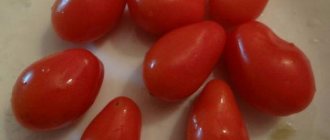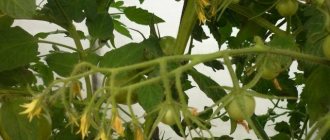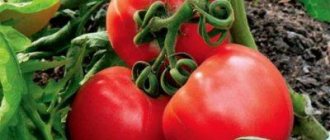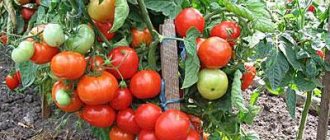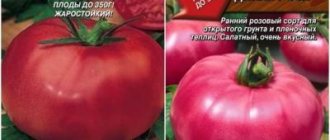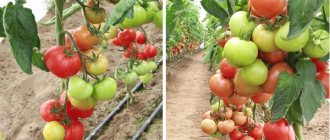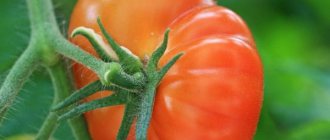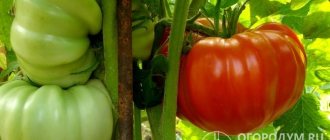Description and characteristics of the tomato variety Katenka F1
On the eve of the new season, summer residents should pay attention to the relatively new hybrid of the first generation F1 - Katenka.
Its early ripening deserves attention. Agree that fresh tomatoes picked in June are a good bonus for the variety.
Summer residents about the Katenka tomato
Reviews and discussions of tomatoes on forums can say a lot about a variety. Here are some opinions about the Katenka hybrid from summer residents.
I grow tomatoes for sale. I prefer early varieties, they are especially in demand on the market. I grow the Katenka hybrid in open ground. I can't say anything bad about him. Seeds from, good seed germination, variety description: yield, other characteristics of tomatoes declared by the manufacturer are true. The taste of the fruit is ordinary, but this is normal for early tomatoes.
Inna, Belgorod
Katenka tomatoes are like a lifesaver for me. Every year I plant several bushes and always have a harvest. The bushes are usually all strewn with tomatoes; they are not large, but very nice: dense, even, without flaws. They begin to sing early and bear fruit all summer. If there is no time, I don’t remove the stepsons; this only increases the harvest.
Description and main characteristics
Katenka is a determinate tomato, intended for cultivation both in open ground and in a greenhouse (film, polycarbonate). The recommended region for growing in soil is the North Caucasus.
The yield characteristics of the variety are excellent. In open ground the yield is from 7 to 10 kg/m²; in a greenhouse this figure is higher.
The characteristics of the variety in relation to diseases are resistance to viral infections (tobacco mosaic) and fungi that cause blossom end rot, late blight, and alternaria.
Fruit
The color of the ripe fruit is red, the average weight is in the range of 120 – 130 g. The fruits are even: round, flat-round. The pulp has a good taste, is quite dense, has 3 to 4 chambers, and contains about 4.6% of the total mass of dry matter in ripe form.
Ripe fruits can be processed into juice or preserved whole. In most cases, gardeners grow these tomatoes for sale and fresh consumption without heat treatment in salads, slices, and as an addition to sandwiches.
Bushes - description and planting scheme
The height of bushes grown in the ground is 0.6 m. In a greenhouse, this value may differ upward. It is recommended to plant up to 6 plants per square meter of ridge. With such density, it is optimal to form a bush with 3 trunks. Leave 2 stepsons for this: one above the first flower brush, the second above it.
Features of care
The height of seedlings before transplanting into the ground (greenhouse) is from 15 to 20 cm. Katenka grows better in illuminated areas, but tolerates light partial shade. The variety is responsive to potash fertilizers. Fertilize after the formation of the first fruits. Work of a summer resident on caring for Katenka’s tomatoes during the season:
- Watering at least once a week.
- At least 2-3 feedings with fertilizers.
- Removing weeds.
- Removing stepchildren.
- Bush garter.
- Loosening the soil between the rows.
Advantages and disadvantages
Information about the disadvantages and advantages of the variety is given in the table.
| Advantages | Flaws |
| productivity | possible damage to the branches (fracture) under the weight of the fruit |
| transportability | require obligatory garter to the support |
| resistance to viruses and fungi | |
| drought resistance | |
| normal fruiting in the rainy season | |
| long fruiting | |
| early harvest – 80 days |
Simple tips for growing tomatoes in the country
You can speed up the ripening of fruits and improve the formation of ovaries using food waste: milk diluted in water, juice from meat, whey. Experienced gardeners recommend watering tomato bushes with them. Watering with such food waste will partially replace fertilizing with organic fertilizers.
If you want a strong tomato bush that bears fruit all summer, plant the seedling bush in the hole not straightly, but at an angle. Additional roots will form on the stem; the more powerful the tomato root, the stronger the plant, the higher the yield.
Excess air dampness in the greenhouse - late blight, blossom end rot and other tomato diseases. Humidity can be reduced by regular ventilation and mulching the beds with hay, straw or dried lawn grass.
If you are afraid of nitrates, use a simple way to reduce them in tomatoes: a day before harvesting the fruits, water the tomato beds generously with running water.
Conclusion
Include the productive hybrid Katenka in your list of tomatoes. The modern variety will meet your expectations for an early tomato harvest. Katenka means a large harvest of quality tomatoes in your garden.
Planting in the ground and caring for tomatoes
Before transferring seedlings to the garden, you should harden the tomatoes. To do this, it is enough to take the plants out into the open air for 2-3 weeks. It is better to do this gradually, starting from 10-15 minutes, daily extending the period of exposure to air.
When choosing a planting site for a tomato, you need to make sure that the area is:
- sunny (although the tomato can withstand light shading);
- protected from the prevailing winds;
- not floodable.
When considering the previous crop, you should abandon the place where they grew last year:
- tomatoes;
- potato;
- pepper.
These plants have many common diseases. Neighborhood with them is not undesirable.
As for soils, they should be:
- lungs;
- air- and water-permeable;
- neutral or slightly alkaline;
- nutritious.
There is no point in planting tomatoes on poor, sandy soils; they will not produce a harvest. In this case, you can improve the land point by point. To do this, prepare a soil mixture consisting of:
- compost - 1 bucket;
- humus - 1 bucket;
- garden soil - 1 bucket.
Before planting, add 1.5-2 kg to each hole. On such soils, Decembrist will not fatten, but will produce an excellent harvest.
After planting seedlings in open ground, the roots should be pressed well and the plant should be watered.
The application of fertilizers to the soil plays an important role:
- The first feeding is done when the shoot begins to grow. During this period, nitrogen is needed. Ammonium nitrate can be used as a nutrient (1 tablespoon per bucket of water).
- The second feeding is carried out 15-20 days after the first, and additional potassium should be added. Potassium sulfate 10-15 g per bucket of water is added to the saltpeter solution.
- The third feeding may not contain nitrogen fertilizers. It is enough to dissolve only potassium.
Under each bush, 0.5 liters of nutrient solution is added.
Important! Plants should not be fertilized without prior watering. Excessive concentration of nutrients will not be beneficial.
The Decembrist tomato bush continues to grow up to a meter. Next comes the end. That is why you should leave a stepson - a daughter process. It is recommended to plant tomatoes in 2-3 stems.
The plant requires garter, since large fruits can break off the shoot. You should start tying up from an early age, and you need massive support.
Description of the hybrid tomato Nonna M, growing seedlings and care
The Nonna M tomato belongs to hybrids that can grow and bear fruit, regardless of climatic conditions and soil. The fruits of the plant tolerate long-distance transportation well. It is recommended to grow tomatoes in open ground in the southern part of Russia, in the middle zone or northern regions - in greenhouses and hotbeds. Nonna M is consumed fresh, added to salads, juices, pastes, and ketchups are made from the fruits. The berries are not suitable for canning as whole fruits.
Technical data of the plant
The characteristics and description of the tomato are as follows:
- Ripening from germination to full fruit lasts 110-115 days.
- The height of the plant bushes ranges from 120 to 180 cm. The leaves on medium-sized stems are colored in a standard green color. The inflorescences are simple.
- Nonna M tomatoes are shaped like a slightly elongated heart.
- Fruit weight is from 0.25 to 0.5 kg. Ripe berries are raspberry colored. The pulp has a high density. This allows you to store the fruits in a cold place for 25-30 days.
Reviews from gardeners growing the Nonna M variety show that plant yields reach 4-5 kg per bush. But this indicator is achievable only if all the rules of agricultural technology and advice from breeders are followed. Most gardeners get from 3 to 3.5 kg per bush.
All farmers note the unpretentiousness of the plant and its ability to withstand sudden climate changes. But at the same time, tomato has disadvantages, for example, it requires the formation of a bush of 1-2 stems.
Nonna M becomes infected with almost all tomato diseases. The plant is susceptible to late blight, blossom end rot, tobacco mosaic virus and other fungal and bacterial infections. Therefore, preventive work is required to spray plants with medicinal agents that prevent the development of diseases.
How to get tomato seedlings?
After acquiring the seeds, they are disinfected in a solution of hydrogen peroxide, aloe juice or a weak composition of potassium permanganate. To cull the seed fund, it is placed in warm water. All floating seeds must be destroyed. The remaining seeds are sown in a suitable container with homemade or purchased soil. After the sprouts appear, the boxes are moved to a well-lit place. You need to water the seedlings and feed them with mineral fertilizers once a week.
When the first leaves (1-2 pieces) begin to bloom on the bushes, the tomato should be pruned. After the seedlings are 50-60 days old, they are pre-hardened for 14 days and planted on permanent soil. The exact timing of this operation depends on the climatic conditions in the region where the farmer lives.
When growing Nonna M, it is recommended to place from 4 to 6 seedlings per 1 m² of bed and form them into 2 stems. Immediately after this, you need to tie the tomato to supports, since the tomato will not be able to support the weight of the growing fruit.
Before planting plants on permanent soil, the beds must be loosened and complex mineral and organic fertilizers added to the soil. After planting, the root system of the bushes is sprinkled with earth and then watered abundantly. To disinfect the beds, it is recommended to use a weak solution of potassium permanganate.
Caring for plants before harvest
To obtain maximum yield, you need to water the bushes with warm, settled water 1-2 times a week. This procedure is carried out early in the morning, before the sun rises. Do not overly moisten the soil under the bushes, as this contributes to the development of certain diseases.
If the tomato is planted in a greenhouse, then the humidity can be adjusted by ventilating the room. This measure will also get rid of some garden pests.
Tomatoes are fertilized at least 2 times throughout the growing season. First, when the tomato is flowering, potassium nitrate, nitrogen fertilizers, and organic matter (peat, humus, manure) are added to the soil. The next feeding is carried out when the first fruits appear. It is recommended to use complex mineral fertilizers containing phosphorus, nitrogen, and potassium. If the soil is poor, then the amount of fertilizing can be increased.
Weeding the beds eliminates the risk of late blight infection from weeds. When Colorado beetles, aphids and other insects appear on plants, they must be destroyed using chemical toxic substances. If they are not available, then use copper sulfate or soap solution. These preparations are sprayed on the leaves and stems of tomato.
Great taste and pleasant appearance - Olesya tomato: description of the variety and its characteristics
Reading reviews about the Olesya tomato, you may decide that this is the ideal variety. People rave about its taste, hardiness, large fruit size and versatility. Thanks to its excellent taste, the tomato is gaining increasing popularity.
| Height | Landing location | Ripening time | Fruit color | Fruit size | Origin | Fruit shape |
| Tall | Greenhouse, Open ground | Mid-early | Orange | Large | Variety | Plum-shaped or oval |
Description and characteristics of the variety
Olesya tomato bushes are indeterminate, tall, about 1.6-1.8 m. The leaves are large, the plant branches moderately. The variety is mid-early, sometimes called mid-ripening - the period of fruit ripening is from 95 to 110 days from the moment of germination. The tomatoes are oval or plum-shaped, quite large - on average 150-300 g, but some gardeners received specimens up to 370 g. The color is deep orange, the skin is smooth and thin. There are some seeds inside.
Tomato Olesya “Siberian Garden” has dense and fleshy pulp and a pronounced tomato aroma. Used for salads, in cooking, for processing into juices and sauces. You can preserve the whole thing, but the skin may crack.
Advantages and disadvantages
- wonderful taste;
- high productivity;
- immunity to late blight and a number of other diseases;
- good transportability;
- durability and ease of cultivation.
Minuses:
Features of cultivation and storage
In the middle zone and colder regions, the variety is planted in a greenhouse, and in the south it grows well in open ground. Needs pinching; the bush is grown in 1-2 stems.
If you choose to form a bush with 2 stems, then per 1 sq. m. place 3 plants, and if 1 stem - 4 plants.
Planting and care
Seedlings should be planted in a permanent place at the age of 60-65 days, therefore the time for sowing seeds is calculated based on this.
First, the seed must be treated against pathogens, fungi and microorganisms. The grains are soaked in a solution of potassium permanganate, aloe juice or hydrogen peroxide, and then rinsed with water. If the seeds were purchased in a store, this step is skipped. Then they are treated with a growth stimulator.
The soil is bought at a gardening store or made up of garden soil, peat (which can be replaced with humus), sand or vermiculite, which will serve for drainage, as well as fertilizers - a little superphosphate and wood ash. The mixture is shed with a 3% solution of potassium permanganate or calcined in an oven to eliminate fungi and parasite larvae.
Grooves are made in the ground at a distance of 3 cm from each other, 1-2 cm deep
The seeds are buried, carefully watered with water, the containers are covered with glass or transparent film and placed in a room with a temperature of +22-25 degrees
Picking is carried out no later than in the phase of 2-3 leaves. Young seedlings are distributed into separate containers.
They are transplanted into the ground when frosts have passed.
Care includes watering the roots with settled water at room temperature, loosening the soil, regular fertilizing, and controlling weeds and parasites.
How to care for a plant?
Seedlings obtained from purchased seeds must be planted in already plowed soil. You can plant in March-April or in the summer.
It is worth keeping in mind that 1 inflorescence on a bush of the described variety is most often formed above the 9th or 10th leaf. It is recommended to completely remove all sprouts below the specified level. If this is not done, the trunk will become heavier and it will be necessary to install supports, otherwise the stem may break.
You need to know that the growth of a plant of this variety ends with an inflorescence. It is recommended to be careful when removing stepchildren. You can limit their number by removing the growth point. It is best to leave the shoot with a new growth point at a level above the 3rd inflorescence.
Since the hybrid variety Dekabrist f1 is resistant to many fungal and other diseases and is not afraid of various pests, any beginning gardener can breed this variety. But it should be noted that watering the bushes should be carried out according to a schedule so that the soil is constantly moist. Every week you need to loosen the beds and weed out the weeds, otherwise you can lose most of the harvest. It is not necessary to tie up the bushes.
Most often, the fruits of the Dekabrist f1 variety are eaten directly from the garden, but they can be canned. Since grown tomatoes of this variety retain their quality for several months, you can prepare various pickles with them not only in summer or autumn, but even in winter.
Tomato Dekabrist f1 is a unique development of Western and Russian breeders. Thanks to the qualities of this hybrid, you will have your own tomatoes in December. This variety of tomatoes is suitable for those who like to surprise friends and relatives with delicacies.
Characteristics and description of the Dekabrist variety
The variety came to the market under the auspices of the Chelyabinsk region, Krasnoarmeysky district, village of Shibanovo. The tomato has not been included in the register of breeding achievements, so the characteristics can only be gleaned from the inventory on the bag and reviews from those vegetable growers who have already grown Dekabrist tomatoes in their gardens.
The hybrid tomato bush does not exceed one meter in height. Massive shoots hold large fruits well, but still require garter. The average foliage of the bush helps the tomatoes to be well lit by the sun.
Seedlings planted at the usual time are in no hurry to form inflorescences, and they are formed only after 7-8 leaves. The growth of the ovary is slow, but by August the bush is capable of producing 8-9 large tomatoes.
The fruit gains weight up to 300-320 g, but is in no hurry to color. The manufacturer recommends picking tomatoes at ripeness and ripening them at home.
The photo shows the beautiful appearance of neatly shaped tomatoes. The fruit is practically devoid of ribbing.
Ripening is very slow. The manufacturer recommends:
- remove tomatoes before frost;
- wrap each fruit in paper;
- put in boxes or baskets;
- send for ripening at a temperature not exceeding 15 ᵒC.
To delay fruit ripening, you need to choose cool conditions. To speed up the process, just put a ripe tomato or a rotten apple nearby. Such fruits emit gas - acetylene, which accelerates ripening.
A ripe tomato is large and dense, red, without a green spot at the stalk. However, the taste leaves much to be desired. A tomato that has been ripening for a long time is not capable of accumulating sugars.
The ratio of acids and sugars is not in favor of taste. Of course, it’s nice to have your own tomatoes in December, but you shouldn’t expect much pleasure from them.
Description of the Kokhava F1 tomato: advantages and cultivation techniques
The Kokhava F1 tomato, bred by Russian breeders, belongs to the first generation hybrids. The variety is characterized by high yield, early fruit ripening, and immunity to diseases of nightshade crops.
Advantages of a hybrid
The characteristics and description of the Kokhava variety indicate very early fruit ripening. Return from the bush occurs 85-90 days after emergence. The plant is intended for cultivation in closed ground conditions and is suitable for extended crop rotation.
The bush has medium-sized dark green leaves and a strong root system. The plant is vegetative, the first inflorescence is formed at the level of the 7th leaf.
Thanks to the improved parameters of the hybrid, tomatoes are resistant to late blight. In this case, damage to the crop by biological pests cannot be ruled out. Therefore, if traces of pests are found on the trunk and leaves, the bushes should be treated with a weak solution of potassium permanganate.
The downside of the culture is that it is impossible to obtain seeds from the hybrid for cultivation next season. With proper care of the crop, the Kokhava tomato bears fruit until late autumn.
Cultivation technique
The tomato is a hybrid, so the seeds must be purchased from a specialty store. Before planting, it is necessary to prepare a soil mixture and treat the seed with a solution of potassium permanganate.
This event is aimed at preventing crop disease and improving plant immunity. The seeds are planted to a depth of 2 cm. The container with planting material is watered with water from a spray bottle and covered with film until the seedlings hatch.
In the phase of formation of the first true leaf, the plant is planted in order to strengthen the root system. The culture is transferred to a permanent place at the age of 55 days. To obtain an early harvest, the crop is planted in a heated greenhouse.
Caring for the plant involves regular irrigation, loosening the soil and periodic application of complex fertilizers according to the manufacturer’s scheme.
Recommendations and opinions of vegetable growers
Kokhava F1 tomatoes, reviews of which among vegetable growers indicate the popularity of the variety, are resistant to tobacco mosaic virus, leaf curl, and cladosporiosis. The practice of cultivating the plant has proven that the yield per 1 m² in an extended rotation of crops can reach 32-34 kg.
Mikhail Dobrolyubov, 58 years old, Borisovo:
“Last year, on the recommendation of relatives, I grew the Kokhava variety at the dacha. I note the high productivity of the plant. From 1 bush we managed to collect 29 kg of tomatoes. A cluster of rich red fruits, like the one in the photo of the packet of seeds. The tomatoes are dense, the flesh is juicy and aromatic, they are perfectly stored for a long time, and are easily transported over distances.”
Irina Filimonova, 52 years old, Pavlovskaya Sloboda:
“I have been interested in growing tomatoes for many years, so I often plant new varieties on the plot
The Kokhava hybrid attracted attention with the shape and rich scarlet color of the fruit. I grew the seedlings myself from seeds purchased at a specialized point of sale.
I separately placed 2 pieces in prepared small pots with soil. seeds, covering with a 1.5 cm ball of soil.
Watered with a sprinkler. Cover the tops of the pots with film and place them in a warm place until the seeds hatch. When 1 leaf appeared, I picked it. The fully formed seedlings were transferred in mid-May. Caring for the plant, applying fertilizer, and mulching the soil made it possible to remove 30 kg of tasty, aromatic fruits from the bush. They keep well in a dark place for a long time and retain their flavor.”
Sowing and growing seedlings
Decembrist tomato F1 does not require a special regime for growing seedlings. Since the hybrid is late, there is no need to rush with sowing.
Seeds are sown in March:
- for the southern regions, March 1-15 is most acceptable;
- northern regions sow from March 15 to March 30.
Provided they are grown in film greenhouses and the tomatoes can be covered until late autumn, planting can be done in April. Amateur vegetable growers in the southern regions practice sowing under light film covers, and they manage to grow good seedlings.
For late varieties, soaking and heating the seeds may not be necessary. But if you are late with sowing, then soaking will speed up germination by 5-6 days.
The soil mixture is prepared in advance or a universal soil for seedlings is used.
Decembrist crops are performed as follows:
- The earth is poured into a bowl and compacted.
- Lightly moisten with warm water from a spray bottle.
- Dry seeds are laid out on the surface at a distance of 3-4 cm.
- Sprinkle with soil and compact.
- Spray with a spray bottle.
- Cover with glass or film to create a greenhouse effect.
Without preliminary wet heating of the seeds, one cannot hope for rapid germination. The “loops” of the first plants can be seen in 10-12 days. During this period, the temperature should be maintained within 24-26 ᵒC.
With the emergence of seedlings, the shelter is removed and the temperature is lowered to 22 ᵒC during the day and 18 ᵒC at night. Watering seedlings is carried out only with warm water. Lighting is very important during this period. Seedling containers should be placed on the brightest windowsill or a phytolamp should be used.
When two true leaves are clearly visible, a pick is made. To do this, remove the plant from the ground and “bite off” a third of the root. This can be done with a nail plate.
The seedlings are transplanted into individual cups or a common tub with a larger area.
At the age of 55-60 days, the seedlings are ready to move into open ground.
Planting in the ground and caring for tomatoes Before transferring the seedlings to the garden, you should harden off the tomatoes. To do this, it is enough to take the plants out into the open air for 2-3 weeks. It is better to do this gradually, starting from 10-15 minutes, daily extending the period of exposure to air.
When choosing a planting site for a tomato, you need to make sure that the area is:
- sunny (although the tomato can withstand light shading);
- protected from the prevailing winds;
- not floodable.
When considering the previous crop, you should abandon the place where they grew last year:
These plants have many common diseases. Neighborhood with them is not undesirable.
As for soils, they should be:
- lungs;
- air- and water-permeable;
- neutral or slightly alkaline;
- nutritious.
Description of the tomato variety Peto 86, advantages and cultivation techniques
Tomato Peto 86 is an early variety and is characterized by high yield. The tomato is popular among vegetable growers due to its excellent taste, versatility of use, and the ability to grow in open ground.
Advantages of the variety
The low-growing bush tomato variety Peto 86 belongs to the Dutch selection. An early, high-yielding variety intended for cultivation in open ground and film greenhouses. From the moment the sprouts appear to the technical fruiting phase, 105-110 days are required.
During the growth process, bushes of medium size are formed.
- The fruits are round, elongated, and resemble plums in appearance.
- Ripe tomatoes of bright red color.
- The fruit pulp is dense, with a high dry matter content.
The characteristics of the variety indicate the crop's resistance to Fusarium wilt and gray leaf spot. Large juicy fruits are set on the bushes regardless of weather conditions.
Tomatoes tolerate transportation well over distances. In cooking, tomatoes are used for canning whole fruits, pickling, making juice, and eating fresh.
Agricultural cultivation technology
Tomato variety Peto 86 is grown in seedlings, in which the seeds are treated with an aqueous solution of potassium permanganate. The seed material is placed in containers with prepared soil to a depth of 1.5-2 cm, moistened with warm water using a spray bottle, and covered with film.
When growing crops, another method is used, in which vegetable seeds are planted directly in open ground. To place the seed at the same depth, you can use peat pots, fill them with soil mixture, place the seeds to a depth of 1-5 cm, and plant them in the holes.
The height of the plant during the growing season reaches 70 cm, so the formation of a stem is not required during the growth process. The best predecessors for tomato variety Peto 86 are zucchini, carrots, cucumbers, cabbage, parsley, and dill.
Caring for the crop involves timely watering and fertilizing with mineral fertilizers. Weeding. It is recommended to loosen the soil near the root system to ensure the balance of air and moisture necessary for normal crop growth.
To minimize weed control, you can mulch the soil using grass or special non-woven black fiber.
Opinions and recommendations of vegetable growers
Reviews from gardeners indicate the excellent taste of the Peto 86 tomato, the transportability of the fruit, and the versatility of use in cooking.
Vladislav Semenov, 61 years old, Stavropol:
“I’ve been interested in growing tomatoes for many years, so I often plant new varieties
The Peto tomato attracted attention with the appearance of the fruit, high yield and compact bush, which during the entire growing season reached a height of 65 cm. During cultivation, I liked the tomato’s resistance to temperature changes
The fruits are calibrated, almost the same size, rich red in color. They do not crack on the bush and retain their shape well when canned. The main thing is to harvest from the bush in time so that the stems do not become deformed under the weight of the fruit.”
Evgenia Kruglova, 51 years old, Volgograd:
“When choosing tomatoes for open ground, I was attracted by the description of the Peto 86 variety, the crop’s resistance to diseases and temperature changes. I planted the prepared seedlings in holes with compost. Throughout the entire period, I monitored the condition of the soil and did not allow it to dry out. The fruits are compact, bright in color, rich tomato taste. Used fresh and for making pasta. Tomatoes retain their taste excellently for a long period after harvest.”
How to grow a plant
The bushes grow tall, so in order to get a good harvest, you need to properly grow the seedlings and care for the adult.
Before planting the seeds, they must be treated with growth hormone. Prepare special soil, previously fertilized with peat or humus. Thanks to such soil, the plant will receive all the necessary nutrients. Seeds must be planted to a depth of no more than 2 cm. After the seeds hatch and seedlings appear, they must be planted.
Description of the Pink Solution tomato and recommendations for growing the plant
Many summer residents ask how to grow Pink Solution f1 tomato, reviews of which they found on websites on the Internet. This tomato came to us from Holland. According to the description of seed producers, it is very tasty, productive and disease resistant.
Characteristics of the variety
The characteristics of the tomato indicate that Pink Solution F1 is an indeterminate plant; it reaches a height of 150 cm. Approximately 2.5 months after the appearance of the first shoots, the tomatoes are fully ripened.
- Ripe tomatoes weigh 200-250 g.
- Their skin is smooth and pink.
- There is a slight ribbing near the stalk.
- The shape is slightly elongated, resembling a heart.
- 1 cluster can produce from 3 to 5 fruits.
The manufacturer's description suggests that high yields are ensured provided that the tomato is planted in a greenhouse. If you decide to plant in open ground, there will be a discrepancy with the description of the seed manufacturer.
How to grow Pink Solution tomatoes?
The room in which tomatoes are planted must have good ventilation. High humidity, which is constantly present in the greenhouse, increases the risk of fungal infection. It is useful to cover the soil in the root area with straw (or any other mulch), which retains moisture, which delays the watering process. It is advisable to water the roots with water at room temperature as the soil dries out.
Since Pink Solution is grown in greenhouse conditions, seeds can be planted in early or mid-March. The planting process, as with all types of tomatoes, is carried out in a shallow container. In order for the grains to hatch quickly, it is recommended to keep them in a special solution before planting that stimulates plant growth.
Experienced gardeners know that any variety of tomatoes does not like poor soil, so they plant the seeds in soil to which peat, sand and ash have been added. And for replenishment, add a solution of complex mineral fertilizer intended for growing vegetable crops.
Similar hybrids
There are quite a few late, mature varieties worthy of attention. According to the characteristics and description, the Dekabrist F1 tomato is similar to the following varieties:
- Long Keeper;
- Fat Carlson;
- Sadik.
Long Keeper is a tomato that needs to sit for 30-35 days after picking to begin to ripen. It boasts shelf life for 70-90 days. The color of the tomato is pale orange. The taste qualities are not high and even when entered into the register, the tasting commission did not give a rating.
Fat Carlson is the latest of all registered tomatoes. At the same time, it has a number of advantages: high yield, large fruit, good taste and resistance to a number of diseases. The color of the fruit is red, like that of Decembrist.
Sadik (Netherlands) is a little popular hybrid, although it has been on the market since 2007. This species is a worthy opponent for the Decembrist. Red tomato, weighing up to 180 g. The garden has a yield of up to 12 kg. sq. m. Excellent taste and very high resistance to a number of diseases make the tomato more and more famous among vegetable growers and summer residents.
Reproduction of the Decembrist
Cuttings are a common method of plant propagation. Cuttings should be taken from a healthy specimen. To get cuttings, you need to carefully unscrew a couple of segments from a plant branch by hand, without using scissors or a knife. Before planting, they need to be dried for several days at room temperature.
When the lower cut dries a little, the cuttings are planted in the ground and the container is covered with polyethylene. Do not root in the sun. It is recommended to ventilate the greenhouse daily. The optimal temperature for rooting is considered to be a temperature range from + 15 °C to +20 °C.


